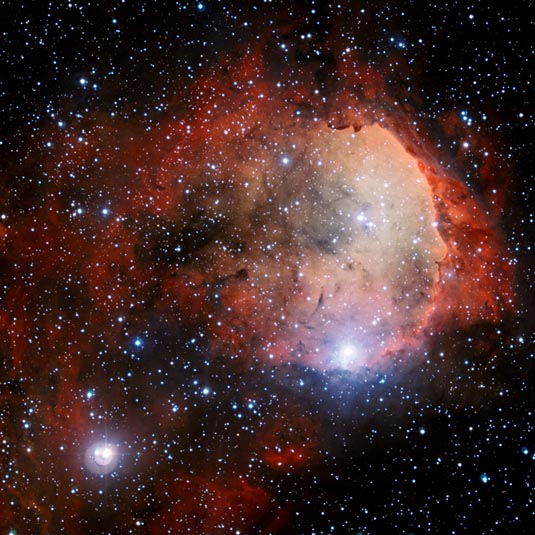
Star Formation Nebulae
RA: 10h 37m 16.88s Dec: -58° 37' 47.52"
Carina
7500 light years
137.57 x 137.57 arcminutes
North is 0.1° right of vertical
ESO
February 1, 2012
Hubble Closeup view: N0834
ABOUT THIS IMAGE:
This image shows a stellar nursery called NGC 3324. It was taken using the Wide Field Imager on the MPG/ESO 2.2-meter telescope at the La Silla Observatory in Chile. The intense ultraviolet radiation from several of NGC 3324's hot young stars causes the gas cloud to glow with rich colors and has carved out a cavity in the surrounding gas and dust.
NGC 3324 is located in the southern constellation of Carina (The Keel, part of Jason's ship the Argo) roughly 7500 light-years from Earth. It is on the northern outskirts of the chaotic environment of the Carina Nebula, which has been sculpted by many other pockets of star formation. A rich deposit of gas and dust in the NGC 3324 region fueled a burst of starbirth there several millions of years ago and led to the creation of several hefty and very hot stars that are prominent in the new picture.
Stellar winds and intense radiation from these young stars have blown open a hollow in the surrounding gas and dust. This is most in evidence as the wall of material seen to the center right of this image. The ultraviolet radiation from the hot young stars knocks electrons out of hydrogen atoms, which are then recaptured, leading to a characteristic crimson-colored glow as the electrons cascade through the energy levels, showing the extent of the local diffuse gas. Other colors come from other elements, with the characteristic glow from doubly ionized oxygen making the central parts appear greenish-yellow.
As with clouds in the Earth's sky, observers of nebulae can find likenesses within these cosmic clouds. One nickname for the NGC 3324 region is the Gabriela Mistral Nebula, after the Nobel Prize-winning Chilean poet. The edge of the wall of gas and dust at the right bears a strong resemblance to a human face in profile, with the "bump" in the center corresponding to a nose.
The power of the Wide Field Imager on the MPG/ESO 2.2-meter telescope at ESO's La Silla Observatory also reveals many dark features in NGC 3324. Dust grains in these regions block out the light from the background glowing gas, creating shadowy, filigree features that add another layer of evocative structure to the rich vista.
The
sharp sight of the Hubble Space Telescope has also been trained on NGC
3324 in the past. Hubble can pick out finer details than the panoramic
view of the Wide Field Imager, but only over a much smaller field of view.
The two instruments when used in tandem can provide both "zoomed-in"
and "zoomed-out" perspectives.